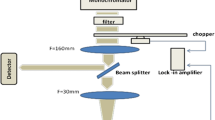Abstract
Photoconductivity techniques serve as useful tools for the characterization of amorphous and microcrystalline silicon. From the link between the majority carrier mobility–lifetime product from steady-state photoconductivity and the position of the Fermi level, useful insight can be gained when comparing sample properties. The temperature dependence of the minority carrier mobility–lifetime product implies that the band-tail region of the density-of-states (DOS) is steeper in microcrystalline silicon than in amorphous silicon. Transient and modulated photoconductivity determine the DOS in the upper half of the band gap, for which we find an exponential variation. We indicate that the Fermi level or quasi-Fermi level impose limitations on the DOS extraction from the measured data. In samples in which the Fermi level is shifted towards the conduction band, the DOS calculation then yields values that are too low.
Similar content being viewed by others
References
Proceedings and Conference Records of recent international conferences like IEEE Photovoltaic Specialists Conference, 2002, International Conference on Amorphous and Microcrystalline Semiconductors, 2002, International Photovoltaic Science and Engineering Conference, 2001.
D. Ritter, E. Zeldov and K. Weiser, Appl. Phys. Lett. 49 (1986) 791.
C. Main, R. BrÜggemann, D. P. Webb and S. Reynolds, Solid State Commun. 83 (1992) 401.
R. BrÜggemann, C. Main, J. Berkin and S. Reynolds, Philos. Mag. B 62 (1990) 29.
J. P. Kleider and C. Longeaud, Solid State Phenom. 44–46 (1995) 597.
R. BrÜggemann, A. Hierzenberger, H. N. Wanka and M. B. Schubert, Mater. Res. Soc. Symp. Proc. 507 (1999) 921.
R. BrÜggemann, J. P. Kleider, C. Longeaud and F. HouzÉ, in “Materials for Information Technology in the New Millennium”, edited by J. M. Marshall, A. G. Petrov, A. Vavrek, D. Nesheva, D. Dimova-Malinovska and J. M. Maud (published by the editors, 2001, Swansea, UK) p. 212.
R. BrÜggemann, J. P. Kleider, C. Longeaud, D. Mencaraglia, J. Guillet, J. E. Bouree and C. Niikura, J. Non-Cryst. Solids 266–269 (2000) 258.
D. A. Anderson and W. E. Spear, Phil. Mag. 36 (1977) 695.
W. Beyer and B. Hoheisel, Solid State Comm. 47 (1983) 573.
J. Kocka, C. E. Nebel and C.-D. Abel, Phil. Mag. B 63 (1991) 221.
H. N. Wanka, Thesis, Universität Stuttgart, 1998.
H. N. Wanka, R. BrÜggemann, C. KÖhler, I. Zrinscak and M. B. Schubert, Mater. Res. Soc. Symp. Proc. 507 (1998) 915.
S. Reynolds, V. Smirnov, C. Main, R. Carius and F. Finger, ibid. 715 (2002) A21.2.
R. BrÜggemann, W. Bronner and M. Mehring, Solid State Commun. 119 (2001) 23.
H.-D. Mohring, C.-D. Abel, R. BrÜggemann and G. H. Bauer, J. Non-Cryst. Solids 210 (1997) 306.
F. Wang and R. Schwarz, Phys. Rev. B 52 (1995) 14586.
I. Balberg, R. Naidis, L. Fonseca, S. Z. Weisz, P. Alpuim, J. P. Conde and V. Cho, Phys. Rev. B 63 (2001) 113201.
R. BrÜggemann, in “Future Directions in Thin Film Science and Technology”, edited by J. M. Marshall, N. Kirov, A. Vavrek and J. M. Maud (World Scientific, Singapore, 1997) p. 80.
R. BrÜggemann, in “Properties of Amorphous Silicon and its Alloys”, edited by T. Searle (IEE, London, 1998) p. 217.
C.-D. Abel and G. H. Bauer, in “Conference Record of the Twenty-first IEEE Photovoltaic Specialists Conference” (IEEE, Piscataway, 1990) p. 1550.
A. Poruba, M. Vanecek, J. Rosa, L. Feitknecht, N. Wyrsch, J. Meier, A. Shah, T. Repman and B. Rech, “Proceedings of the Seventeenth European Photovoltaic Solar Energy Conference” (Munich, 2002) p. 2981.
R. BrÜggemann and J. P. Kleider, Thin Solid Films 403–404 (2002) 30.
C. Main, J. Berkin and A. Merazga, in “New Physical Problems in Electronic Materials”, edited by M. Borissov, N. Kirov, J. M. Marshall and A. Vavrek (World Scientific, Singapore, 1991) p. 55.
F. Finger, S. Klein, T. Dylla, A. L. Baia Neto, O. Vetterl and R. Carius, Mater. Res. Soc. Symp. Proc. 715 (2002) A16.3.
Author information
Authors and Affiliations
Rights and permissions
About this article
Cite this article
Brüggemann, R. Photoconductivity studies of n-type hydrogenated amorphous silicon and microcrystalline silicon. Journal of Materials Science: Materials in Electronics 14, 629–633 (2003). https://doi.org/10.1023/A:1026189912090
Issue Date:
DOI: https://doi.org/10.1023/A:1026189912090




